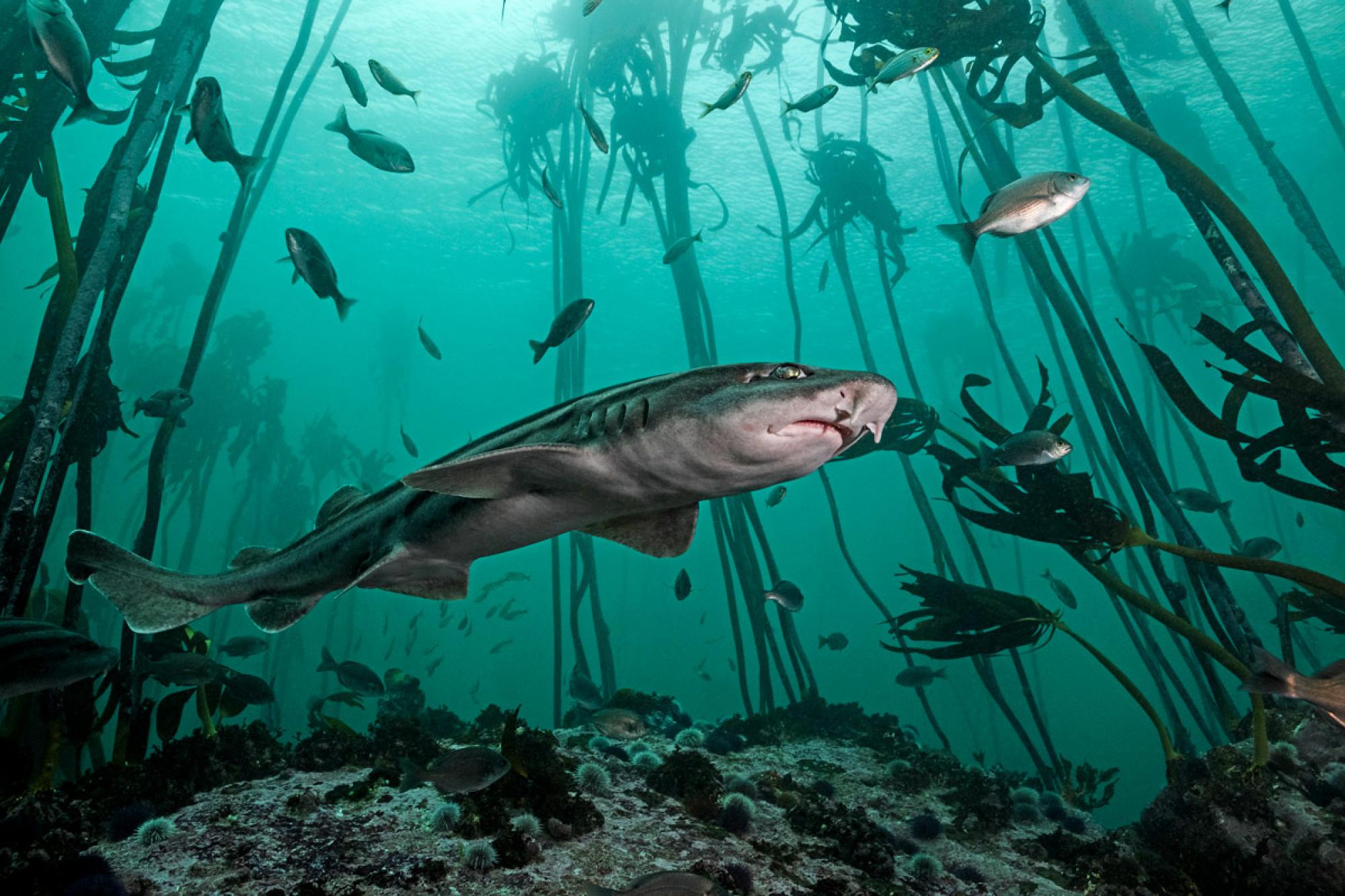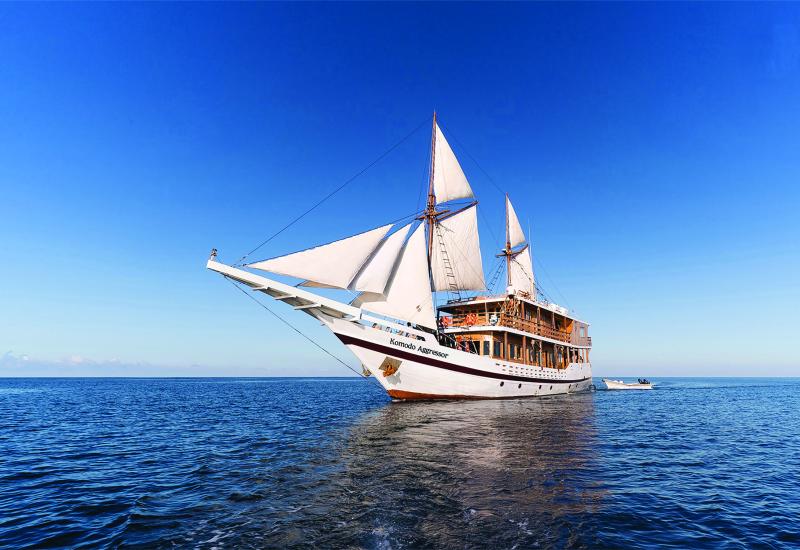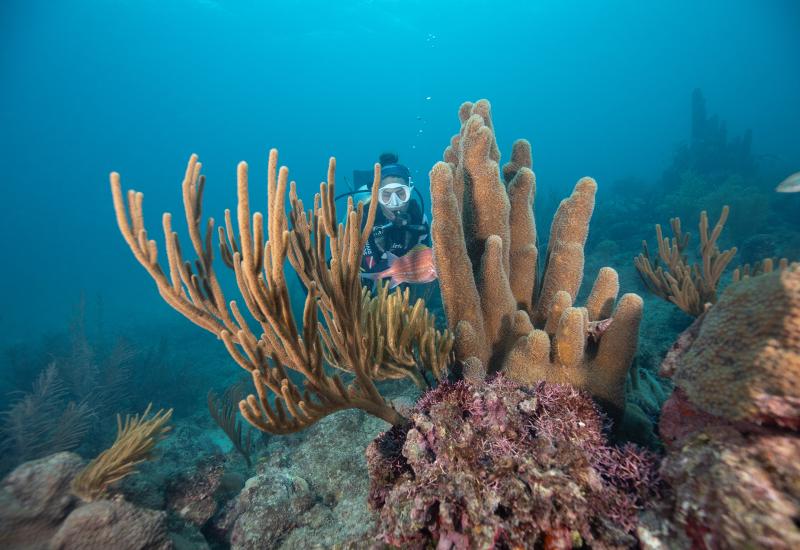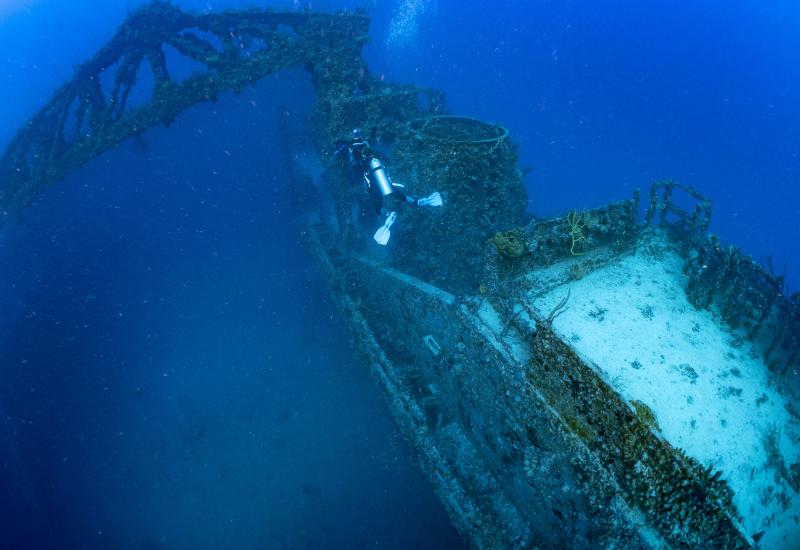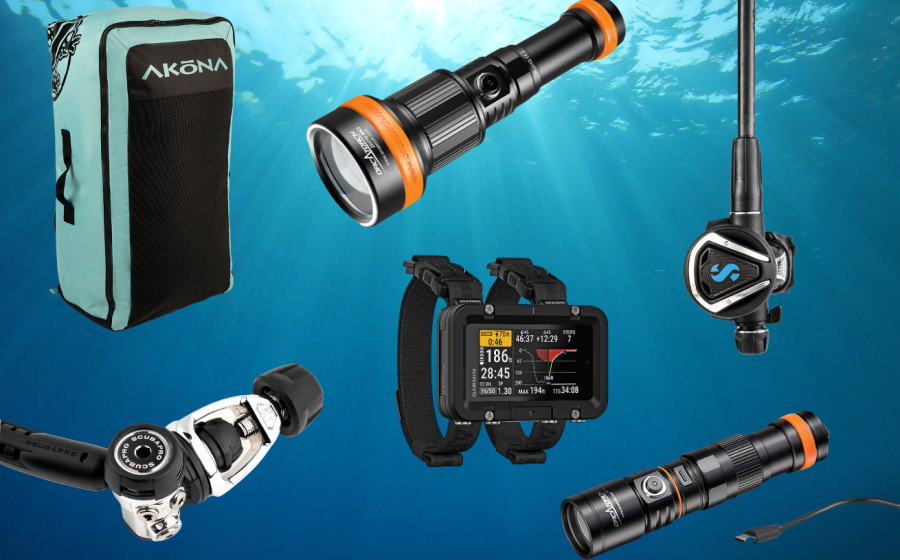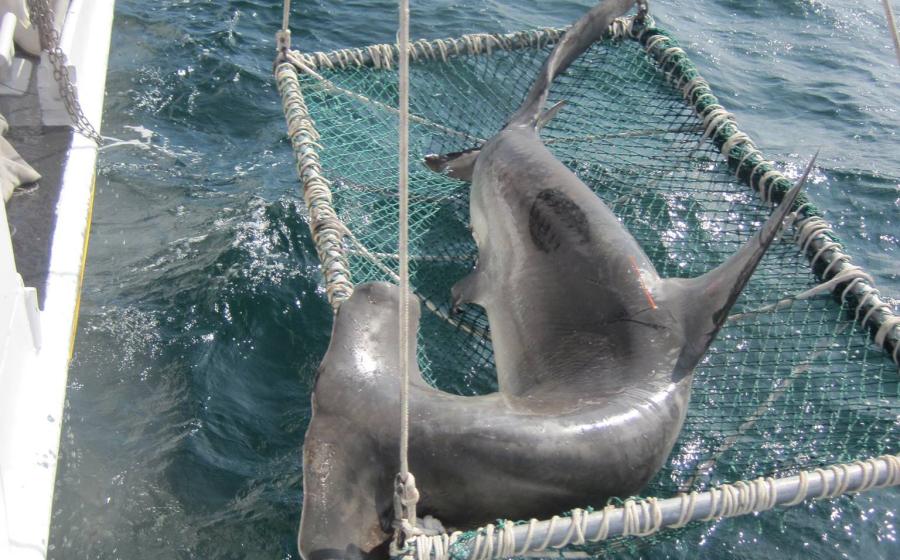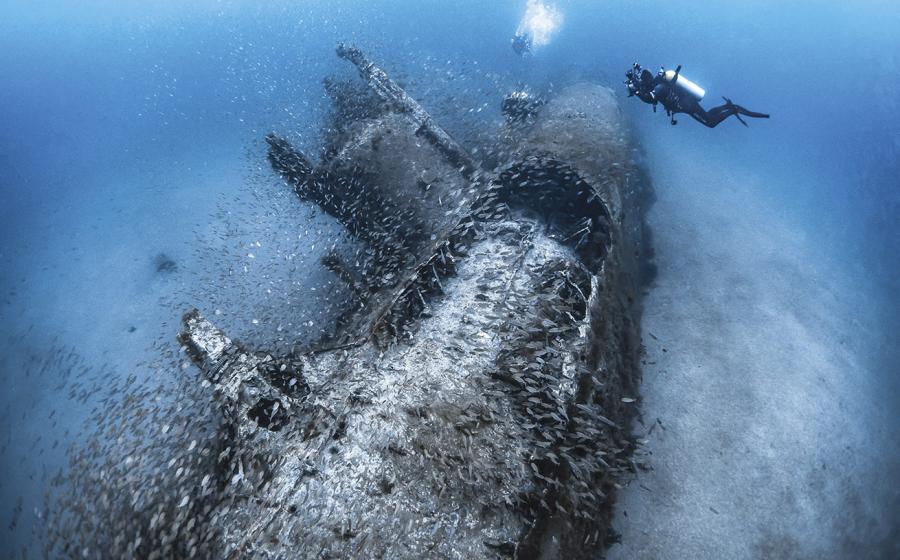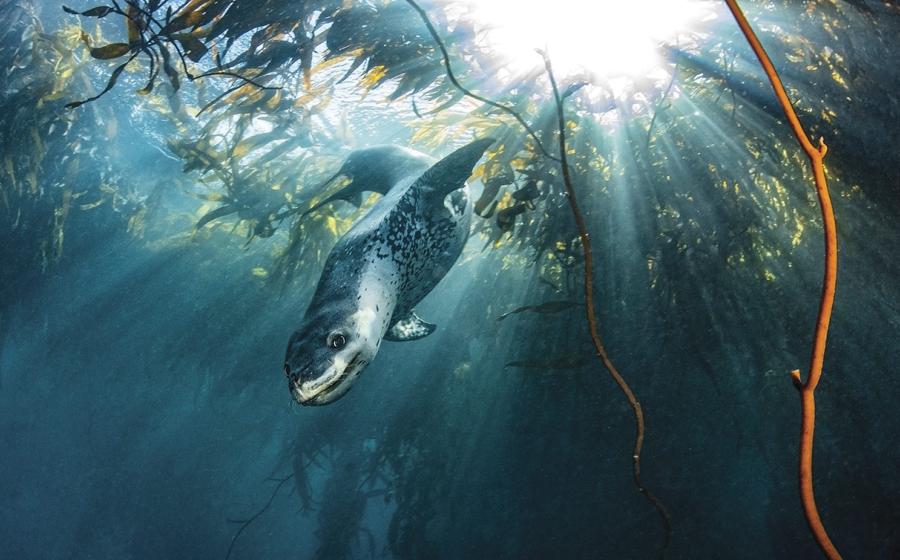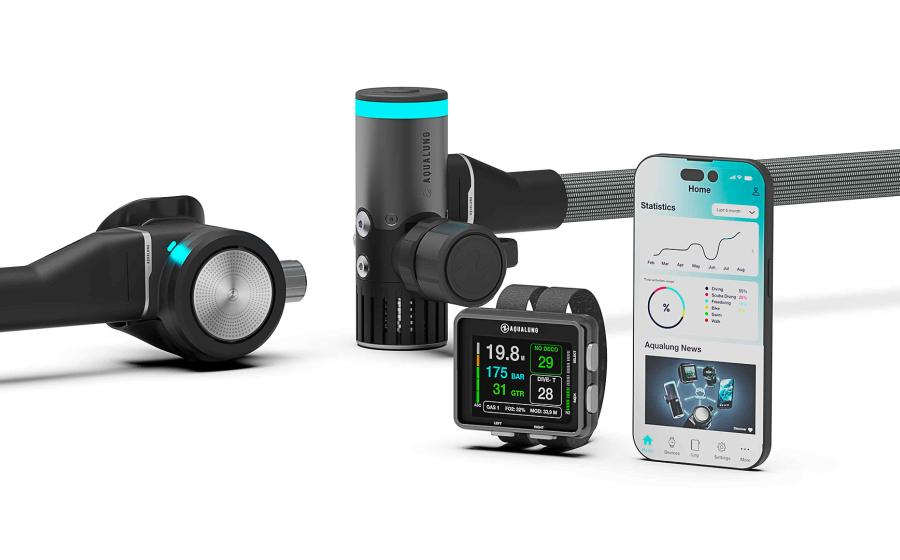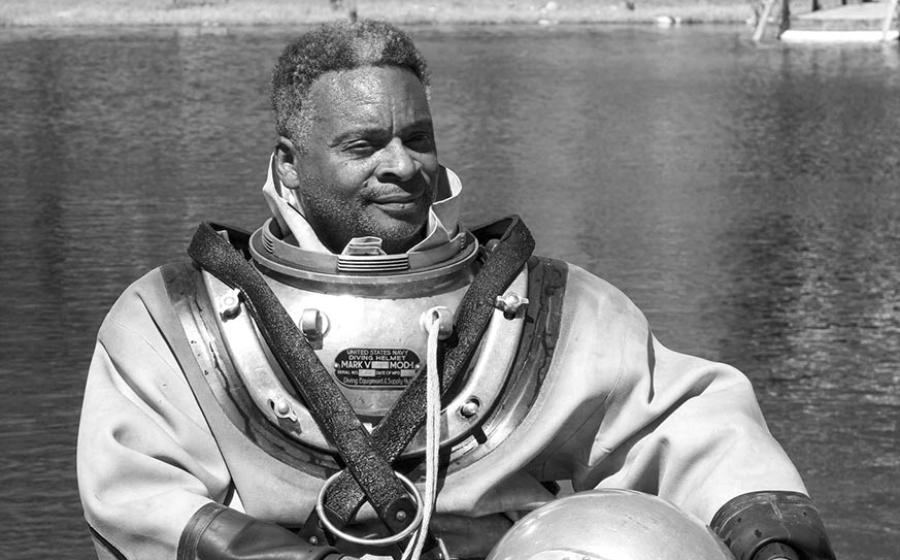Cape Hopping in South Africa on a Drive-And-Dive Trip is Peak Adventure
I have been captivated by the capes since my first trip to South Africa more than 20 years ago. That expedition was all about cage diving for great white sharks, though I did manage to squeeze in a few critter dives on the coastal reefs and kelp beds. What I saw between Cape Town, on the Western Cape, and Port Elizabeth, on the Eastern Cape, left me hungry for more. It moved me. That is, metaphorically, in the “Amazing! I need to do this again someday” way, which is an altogether different manner of movement than the colossal groundswell that now throws us to and fro 10 feet at a time. It’s as if Neptune is vigorously sweeping the seafloor with a giant, invisible broom, hellbent on vanquishing the unsightly, human detritus marring an otherwise picturesque tableau. The many sea fans around us, bright as firebrands, bow to the surge, back and forth like heavy-metal rockers. Head up, head down, then a rebellious swirl of their splendid hair for dramatic effect.
Visually striking as the scene is—red and orange thrashing against a smoky, jade-green backdrop—the debilitating G-forces threaten to eject my breakfast. Whether this would be to the delight of the fishes flying about, I do not know. Many are species I’ve never seen before. Endemic to this southern shore, they are found nowhere else on the planet—very exciting stuff for an ichthyophile like me. I long for a proper introduction, and images, under much more accommodating conditions. Hopefully such a time will come after the sea’s mood swings about for the better.
Sharks And Seals In Simon's Town
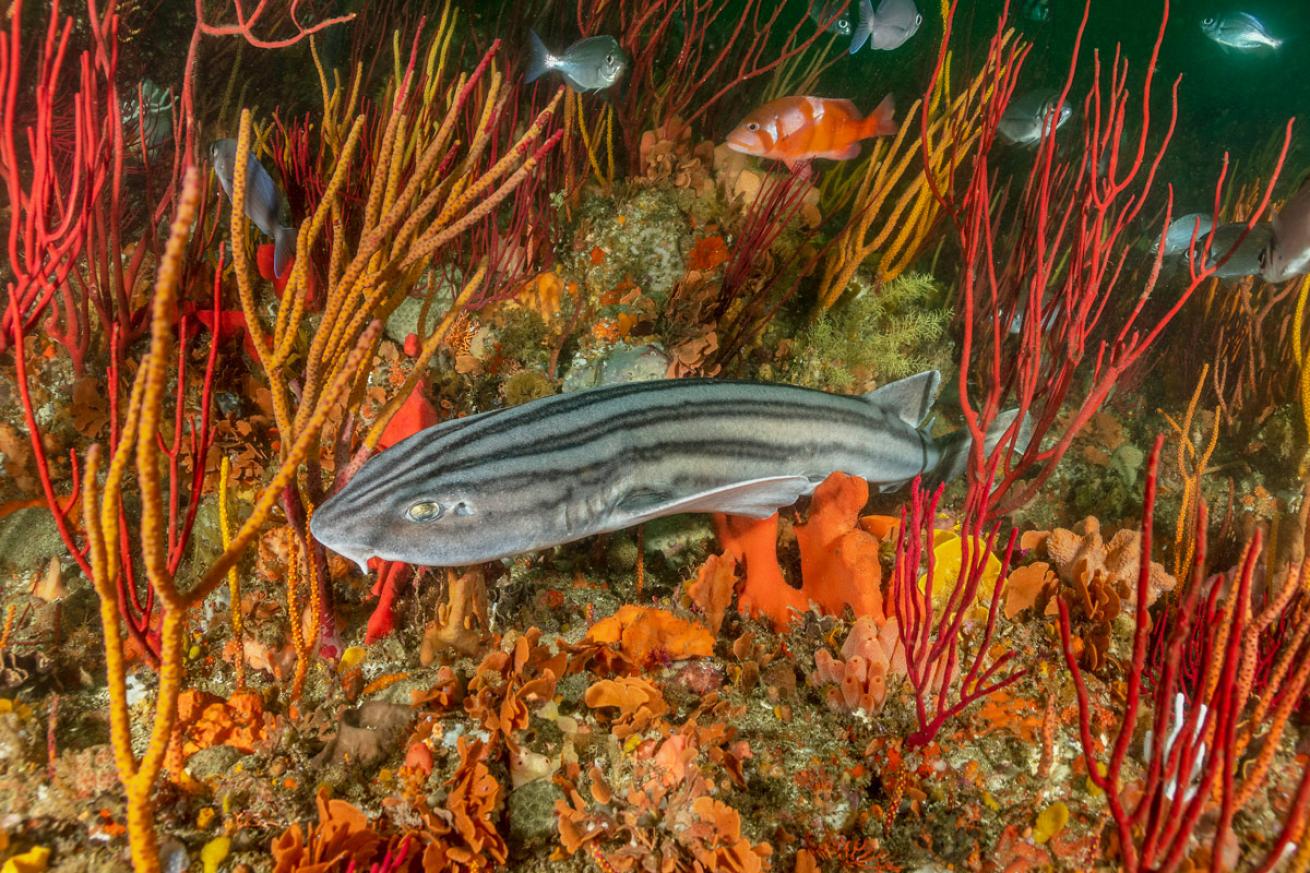
BRANDON COLEA pyjama shark on an offshore reef
What a difference a couple of days can make. The swell has mellowed significantly, and the screaming southeast winds are now a gentle whisper. We surge back into action. My wife, Melissa, and I, along with our dear friends and globe-trotting dive buddies Allyson and Rich, count down and back-roll into the blue-green at Ark Rock just outside Simon’s Town Harbour in False Bay’s northwestern corner. I have sharks on the brain. South Africa’s cool, coastal waters teem with harmless little catsharks. Our divemaster Ernest takes point and finds the first. At just 15 inches long, the puffadder shyshark resting on a bed of empty mussel shells is a beauty painted in bronze and copper. Next up is a slightly bigger dark shyshark, and then a couple of stunningly marked leopard catsharks. The rocky ledge on which we encounter this shiver of sharks is only 20 feet deep and completely covered with colorful invertebrates. Urchins, sea stars, anemones and sponges are all crammed together, forming a messy living quilt of spines, arms and tentacles perfectly suited as a vibrant background for my photo craft. Last to glide onto the stage, and the largest of our elasmobranch brood, are the pyjama sharks, 2 to 3 feet in length and wearing handsomely striped gray and black jailhouse jumpsuits. All four species are—you guessed it—endemic, gracing only these biologically blessed waters. And all are, in the words of Melissa, “so cute I want to take a few home in my BCD pockets.” A girl can dream.
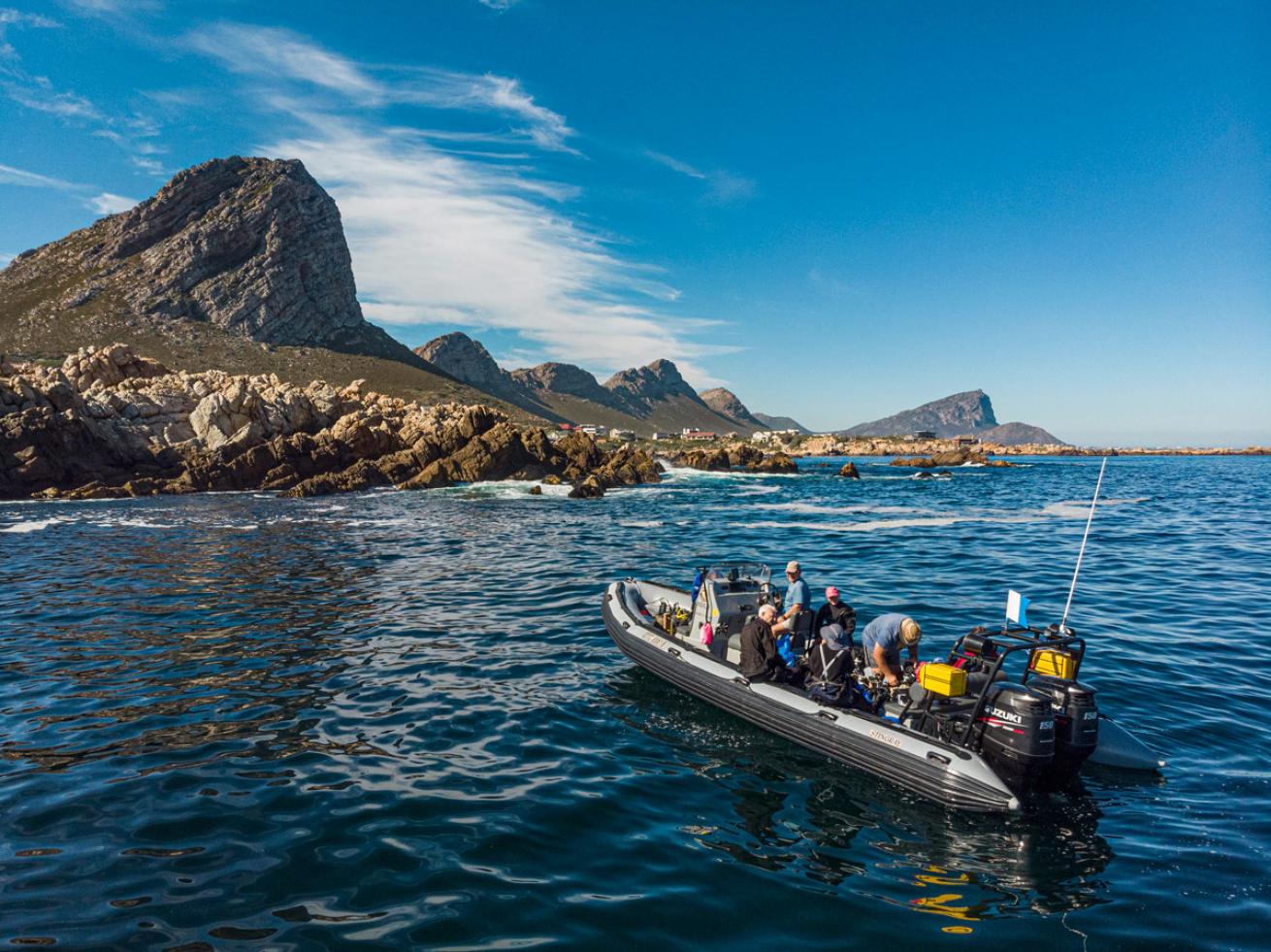
BRANDON COLEA group prepares to dive the shallow kelp beds off the town of Rooiels on the east side of False Bay.
Eighty minutes in the 55-degree water reminds me why I’m a die-hard fan of temperate marine ecosystems (and drysuits) the world over. Named in honor of Noah’s animal ferry, Ark Rock is full to the gunwales with a wondrous cargo of marine life. A bit farther down Cape Peninsula, we resubmerge off Miller’s Point in the kelp forest home of the cephalopod made celebrity by the documentary film My Octopus Teacher. We meet the superstar’s camera-shy cousin, plus more catsharks, red roman fish, hottentots and a hagfish. Affectionately named “snotslang” in the Afrikaans tongue, this lamprey-like animal is a prodigious producer of mucous when threatened by predators. Good to know. Cape fur seals are the star attraction at Partridge Point. Most of the roughly two dozen seals keep to themselves. A handful are curious, however, and eventually make close passes, exuberantly showing off their peerless acrobatic prowess. Though the reef itself is quite pretty at Partridge, it requires extreme tunnel vision to focus on encrusting tunicates and soft corals rather than the playful pups staring at you with wide, soulful eyes and sticking their whiskers into your camera’s dome port.
A Change of Footwear
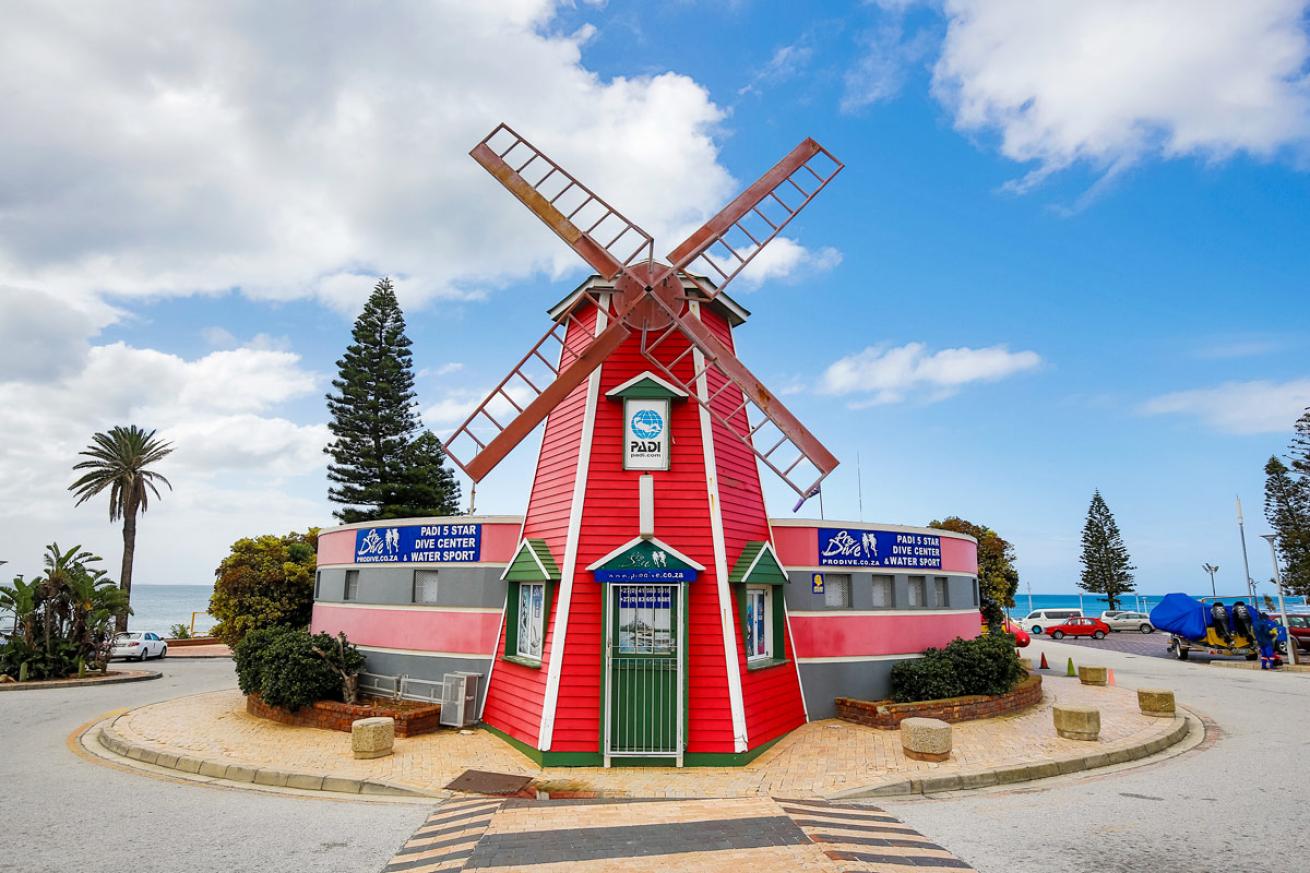
BRANDON COLEThe beachside storefront of Pro Dive Port Elizabeth
Just when we think we are on a roll, in rolls another storm, nixing our scheduled boat charter heading way offshore to chum for blue sharks and makos. In a country where penguins waddle across roadways and cheeky (and sometimes scary) wild baboons can steal the Mountain Dew out of your hand, it helps to be nimble on your feet and agile with your planning.
Thankfully, there’s no shortage of things to do topside on South Africa’s Western Cape. Those lovable penguins are braying, nesting, surfing and strutting right next door at Boulders Beach. We hike up to the top of Table Mountain via Platteklip Gorge (a real StairMaster workout), through the fynbos on the Cape Peninsula, and down to the Cape Point lighthouse standing guard atop sandstone cliffs at land’s end. We stroll along the Olifantsbos Shipwreck Trail to ogle the battered, rusting hulks of unlucky ships now mostly buried by the shifting sands.
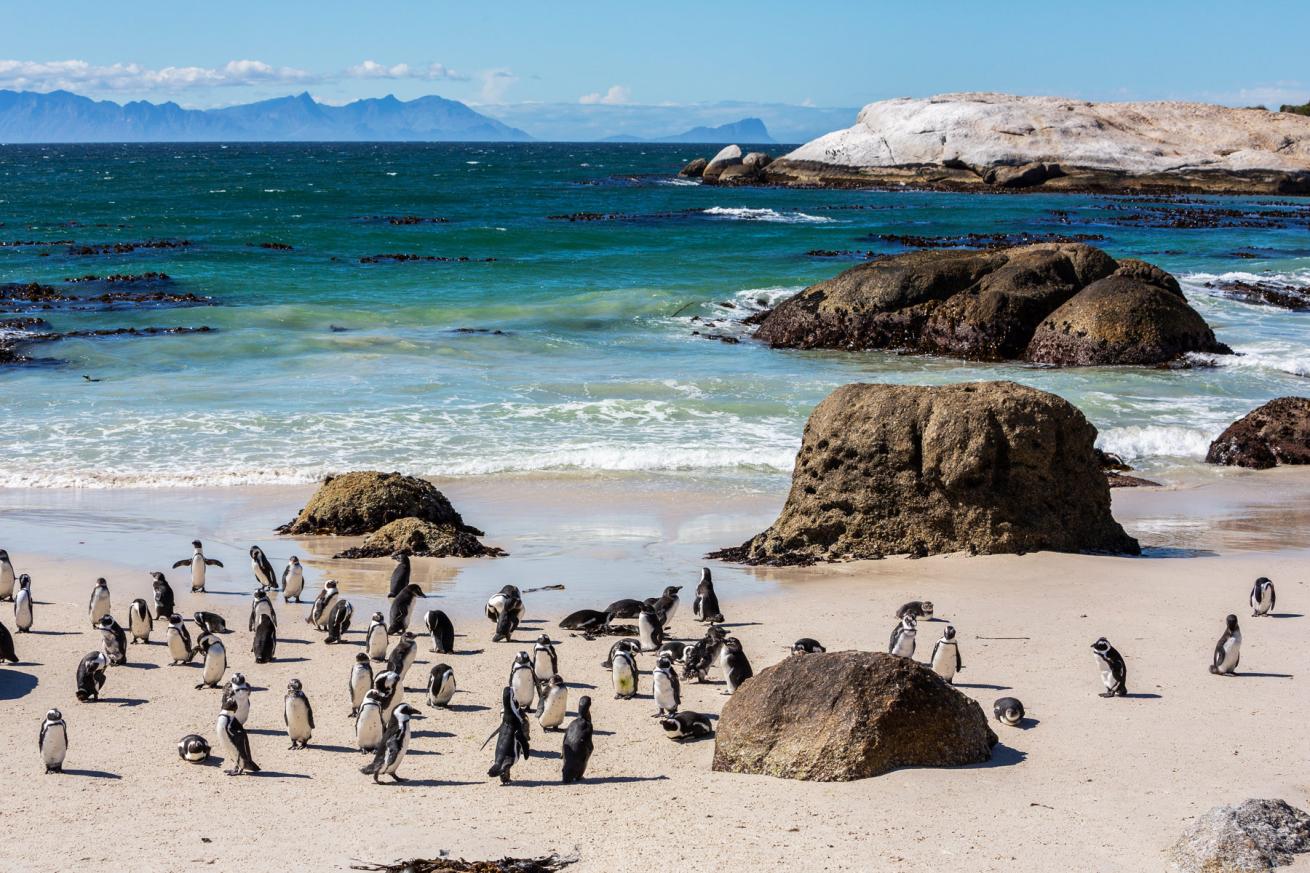
BRANDON COLEAfrican penguins (Spheniscus demersus), endemic to the waters of southern Africa, mill about on Boulders Beach near Simon’s Town.
Another day sees us driving through sun-kissed Stellenbosch wine country and over to Gansbaai for a fat-bike ride down the sand dunes in Walker Bay Nature Reserve. Then it’s a quick detour to watch crashing waves at Cape Agulhas, the true southernmost point of Africa. This is the meeting place of the Atlantic and Indian oceans and their cold Benguela and warm Agulhas currents, ever-clashing titans of the brine. A spectacular place to witness the sea’s wrath, but not to scuba dive.
In a country where penguins waddle across roadways and cheeky wild baboons can steal the Mountain Dew out of your hand, it helps to be nimble on your feet.
Rainbowed Reefs And Raggies in Algobay
False Bay weather forecasts predict a rough-and-tumble sea experience for a few more days. We huddle and then decide to continue cape-hopping and strike out for Port Elizabeth. We’ll try our luck in the Eastern Cape province. “PE” is 465 miles from Cape Town, and travel via plane is possible but would require carefully packing away all the diving and camera gear just to laboriously unpack and reassemble it again in a few hours. Drive-and-dive is more our style. The nine hours in our stuffed-to-the-gills rental hatchback flies by as we cruise the scenic Garden Route and chatter about brand-new waters on the horizon.
To reach said frontier, we launch a 26-foot rigid-hull inflatable boat through the waist high surf with the aid of a tractor, human ingenuity and diver muscle. The Pro Dive team has the exercise down to a science, and in no time flat we are skimming east on a moderately heaving sea to Evans Peak more than 10 miles distant. One of the premier dives in Algoa Bay and a designated marine protected area, the broad seamount rises from the deep to within 55 feet of the surface. This spot has been on my radar for years. Of course I still have sharks on the brain, along with a slew of other critters.
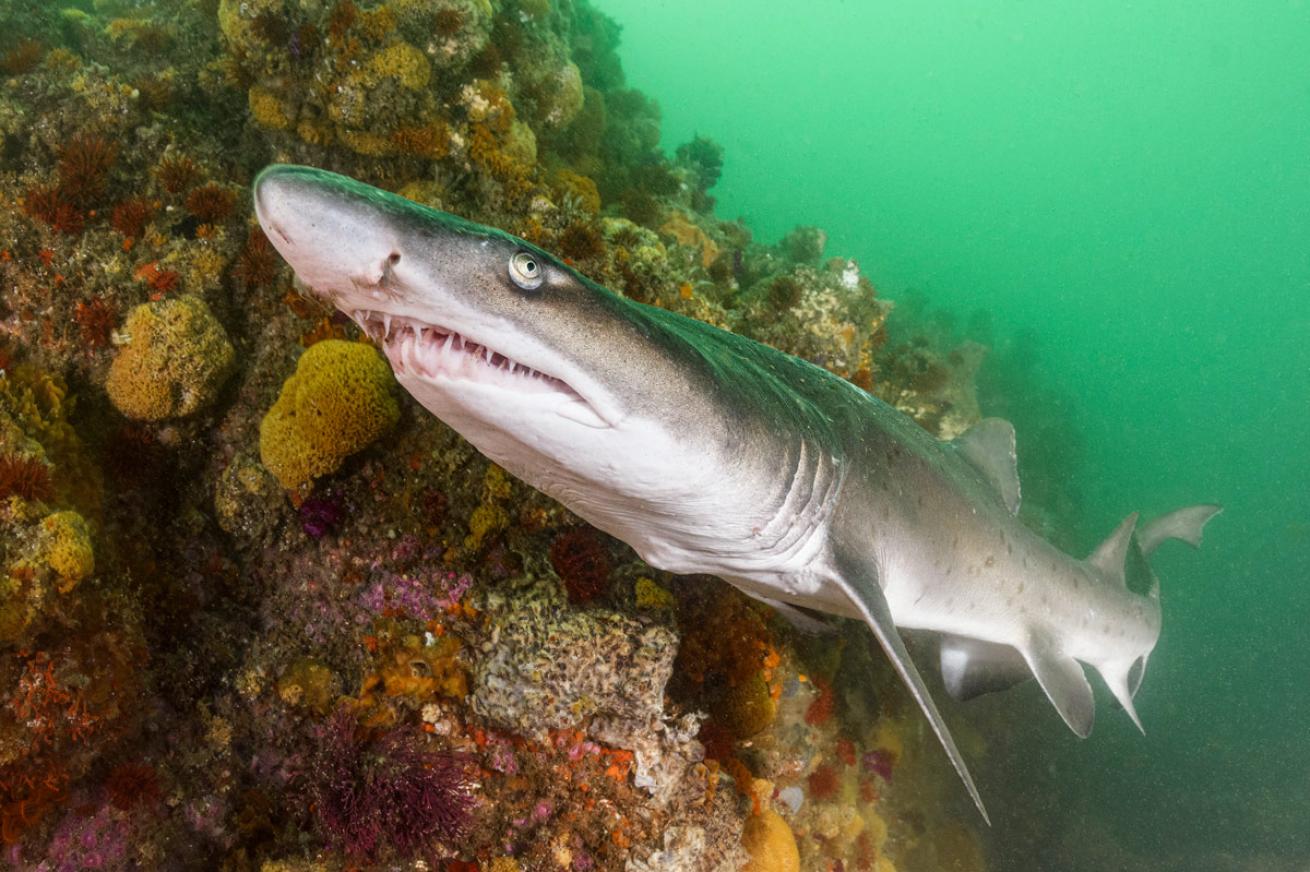
BRANDON COLEA ragged-tooth shark, or raggie, in South Africa’s Algoa Bay.
Once underwater, it doesn’t take long for us to add another cool shark to our logbooks. Fifty-some seconds to descend to 80 feet, and bingo, there it is with a sly grin full of gleaming, barbed wire dentition. The shark glides casually past us and down into a ravine with walls luxuriantly lined in burgundy sea whips and orange gorgonian twig corals. Franco, co-owner of Pro Dive and our guide for the day, signals for us to stop here and wait. Sure enough, the snaggletoothed beast reappears from the gloom a moment later and angles up the slope. In North America, we call them sand tigers. In Australia, they go by the moniker gray nurse. In this part of the world, they are known as ragged-tooth sharks, or simply raggies.
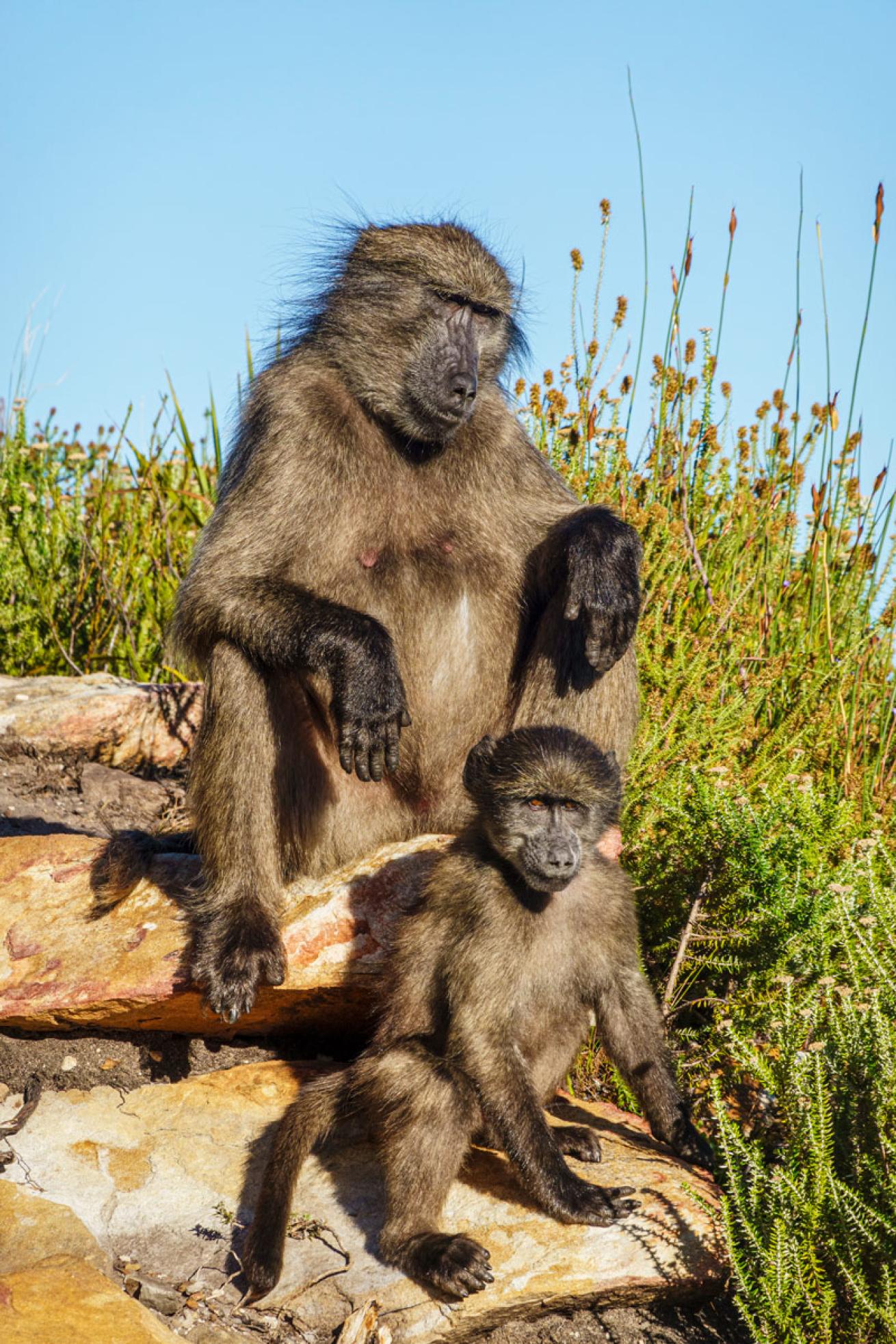
BRANDON COLEA mother and juvenile Cape baboon on the hiking trail.
We encounter a half dozen more raggies patrolling the gullies on a reef close to shore aptly named Shark Alley. Visibility is a challenging 10 feet, but the shallow 30 to 40-foot depth gives us extra bottom time and the sharks are more acclimated to the paparazzi. Double bonus. In the afternoon we visit nearby Addo Elephant National Park for a self-drive safari through the expansive reserve.
The next day we sign up for two deeper dives showcasing more of Port Elizabeth’s impressive fish diversity and polychromatic inverts. Thanks to the profusion of whip corals and sponges at Riy Banks I can expect my retinas to remain pleasantly aglow long after our dip down the wall to 90 feet. In the fish department, red stumpnose, schooling strepies, a leopard catshark and google-eyed, silvery fransmadams keep my camera busy at this advanced site. The stream of yard-long yellowtail amberjacks vortexing around us during our safety stop will also be seared into memory.
We explore Thunderbolt Reef on the exposed, western “wild side” of Cape Recife. On this collection of pinnacles there are florets of curry-colored cauliflower soft corals, grape finger tunicates, clumps of bryozoans bearing an uncanny resemblance to potato chips, bold romans and weird, whiskered catfish (I’m not making this stuff up). Redfinger fish are perched in bubblegum-pink clusters of noble coral that remind me of hydrocoral thousands of miles away in Central California, another of my favorite cold-water scuba hotspots. Thunderbolt strikes a collective chord. All of us would gladly repeat this stellar site.
Gordon's Bay, Take Two
Arm wrestling Mother Nature comes with the territory when diving in demanding, ever-changing marine environments. If at first you don’t succeed, try again. Chasing a new, favorable forecast, we have raced back to the Western Cape. Our first glimpse—first in the past week, that is—of the harbor town of Gordon’s Bay and the shining sea beyond comes as we are coasting down the steep, serpentine decline through Sir Lowry’s Pass on the N2. The ocean looks flat as an indoor swimming pool. Neptune must be napping.
To reach said frontier, we launch a 26-foot rigid-hull inflatable boat through the waist-high surf with the aid of a tractor, human ingenuity and diver muscle.
We are met by wide smiles and good news. Deon and Kate, owner-operators of Indigo Scuba Diving Centre, warmly welcome us back and boost our morale to dizzying heights when they exclaim how much conditions have improved compared to the first time we were here. We jump on board their super-deluxe, military-worthy RIB Indigo, cast off lines, and motor out of the harbor to resume our exploration of the eastern half of False Bay.
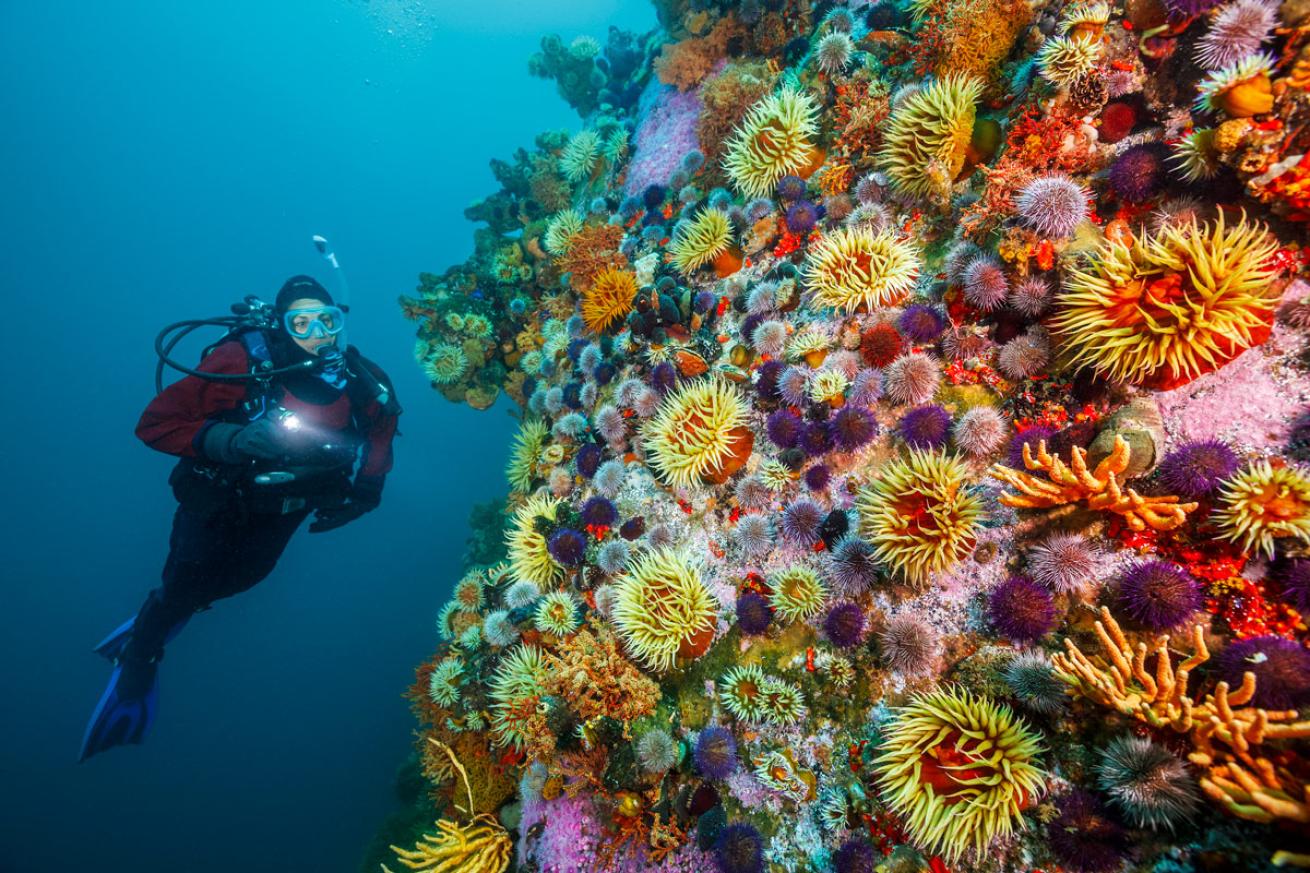
BRANDON COLEA diver illuminates a vibrant pinnacle bursting with color in False Bay.
Sterretjies Reef is, quite simply, fantabulous. Sea fans—of the palmate, sinuous and flagellar varieties—fill the valleys between rocky spurs. We weave a winding path through their elegantly arcing forms, pausing repeatedly in the gently swaying field of scarlet and tangerine to admire the many basket stars attached to the fans’ feathery branches. (Sterretjies means star, or asterisk, in the local lingo.) Strikingly patterned with black and white spots and bands, these are the sexiest basket stars I’ve ever seen. I muse that everything in the here and now—the fans, the fishes, the feeling—is perfect, idyllic. Which is rather ironic, really, because this Elysium is the very same site as that inauspicious beginning to this trip—the inhospitable, stomach-lurching, and most frustrating of tsunami surge dives a fortnight ago, when even the sterretjies had to maintain a death grip lest they spin away into oblivion.
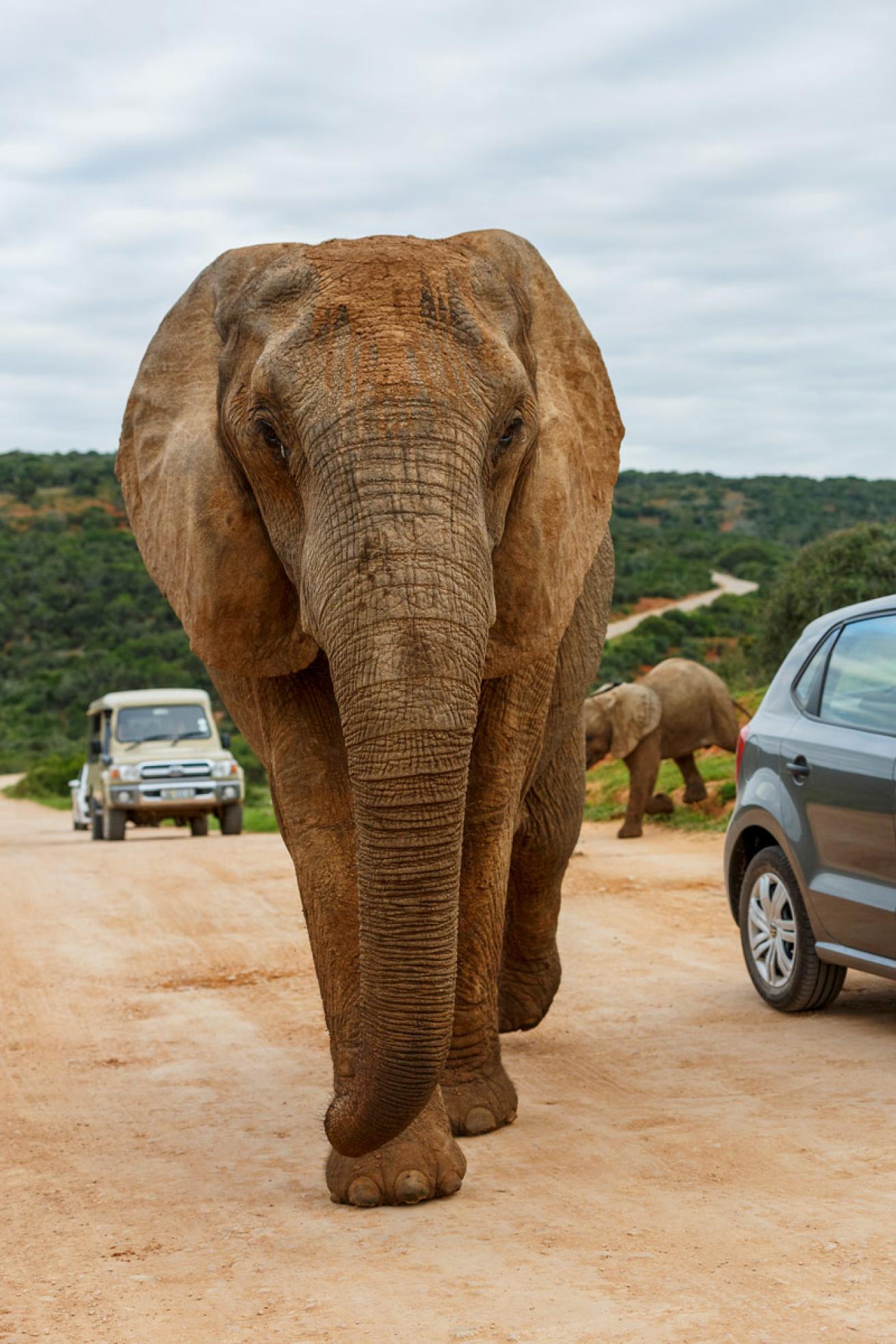
BRANDON COLEAn African elephant roams the grounds of Addo Elephant National Park
Four miles offshore the mouth of the Steenbras River lies rarely dived Steenbras Deep, a mile-long ridge oriented north-south that tops out at 65 feet and bottoms at the century mark. Nothing breaks the surface to mark the spot, so Deon uses GPS to maneuver Indigo to the preferred drop zone. There’s a little surface current running. He will remain topside, following our bubbles to facilitate easy pickup.
Kate, one of South Africa’s top underwater photo pros, briefs us on the site’s topographical and zoological features. We follow her expert lead below and are hugely rewarded with nonstop sightings of remarkable critters, from charismatic horned blennies to microscopic hunchback amphipods. Allyson and Rich are understandably ecstatic to meet at least 10 nudibranch species, including blue gasflames and purple ladies. Personally, I am more enamored of the very photogenic speckled klipfish. And Melissa, ever wary of fomenting a riot among friends, refuses to take sides, declaring all these creatures, slimy and scaly, are worth traveling across the world to see.
Over tea and marine life ID books we discuss the dives so far, those yet to do, and as usual, exactly what the internet’s various wind algorithms and wave buoys prophesy for the future. All four of us are keen to tangle with kelp again before traveling back home across the Atlantic. When the Indigo folks suggest the kelp forests near Rooiels village, which to my waterlogged ears sounds too eerily similar to the rooibos tea I’m drinking to be dismissed as mere coincidence, I cast my vote without hesitation.
The jungle surrounds us, towering above, reaching toward us from all directions. We wander through the swaying forest of split-fan kelp at Coral Gardens, not in a hurry and not needing to go anywhere in particular, only needing to soak it all in—the motion and mood, splashes of brilliant color, the play of light and shadow. A school of seabream glitters through a gap in the amber veil to our right, and a fur seal lazily spirals by to the left. Below, a phalanx of crayfish wave their antennae, peering up out of a crevice carpeted in fuchsia-hued strawberry anemones. We almost miss the rocksucker hiding in plain sight on coralline algae. I most certainly would have missed the cunningly camouflaged octopus had not Melissa seen through its cloaking device. Four eyes suddenly riveting upon it, the octo inflates to almost 3 feet across, then jets away to disappear in its den.
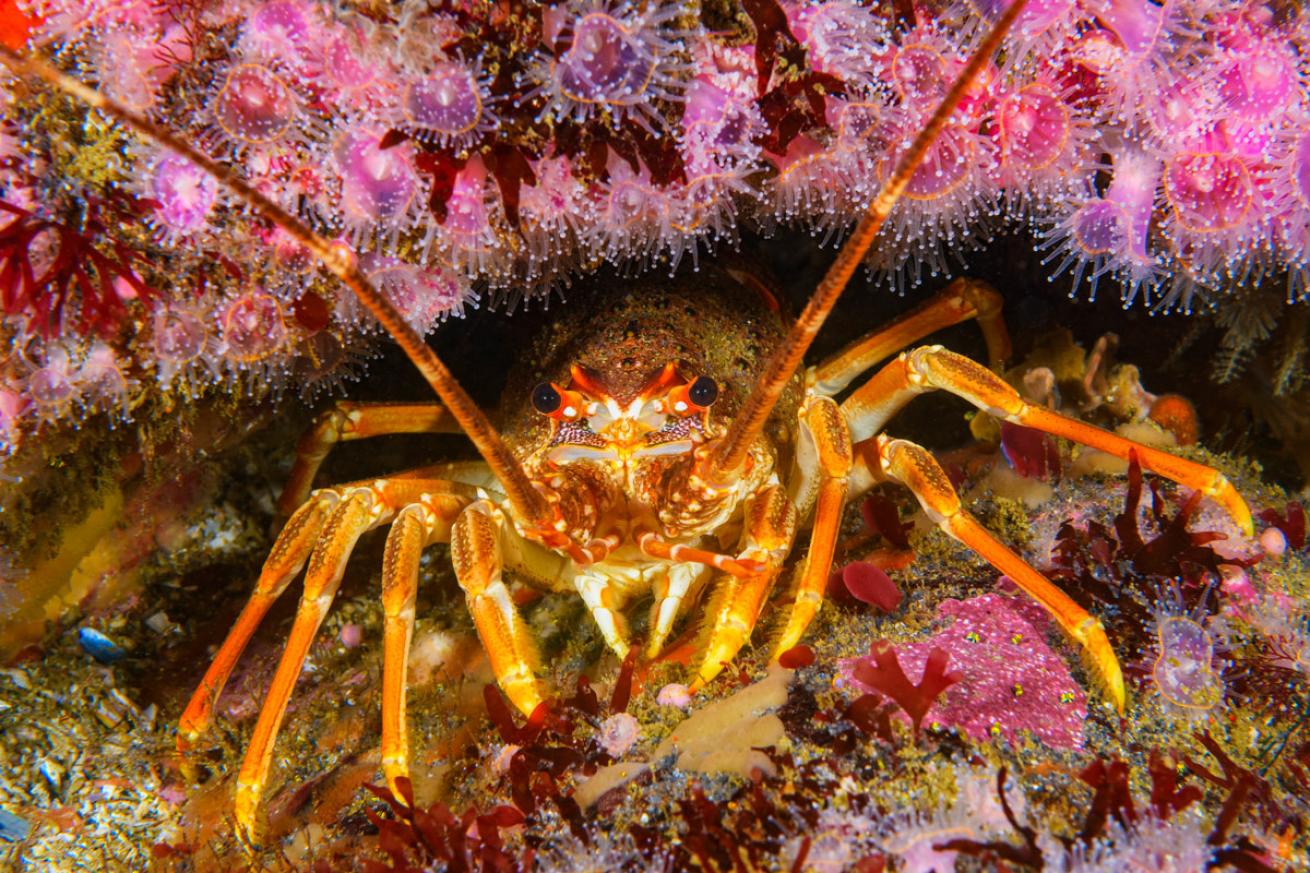
BRANDON COLEA Cape rock lobster hides among strawberry anemones
Continuing onward, we pass curtains of gorgeous sea fans hanging from angled mini walls and freakishly large pumpkin-shaded wall sponges. Eventually we’re drawn into a natural amphitheater in 40 feet of water. Boulders the size of cars are topped with trees of kelp, ringing the space. Light filtering downward through the canopy illuminates hundreds of feather stars with arms unfurled to the sun in worship like caramel-colored lilies of the sea. My breath catches; I’m deeply moved by the beauty in front of me. It was in a place between worlds very much like this that the seed of intrigue was planted in my mind during my first South Africa dives so long ago.
Light filtering through the canopy illuminates hundreds of feather stars with arms unfurled to the sun like caramel-colored lilies of the sea
The Rainbow Nation, South Africa’s popular nickname, conventionally refers to the rich, colorful mix of its many different peoples, languages and cultures. It just as eloquently reflects the community beneath the waves. These mercurial seas possess such compelling character and host a full-spectrum array of fascinating life forms. Cradled in the embrace of the capes, the resplendent reefs and captivating kelp forests guarantee a diving experience unique the world over.
Need to Know
When to Go
Diving in South Africa is possible year-round. I’ve personally experienced good, and not so good, conditions during summer, winter, spring and fall. Weather, sea surface conditions and underwater visibility are highly variable throughout the year, and very difficult to predict. Generally speaking, however, in the Western Cape’s False Bay area the best diving conditions are between the months of February and May diving out of Simon’s Town, and October and May out of Gordon’s Bay. On the Eastern Cape, Port Elizabeth is usually best between January and July.
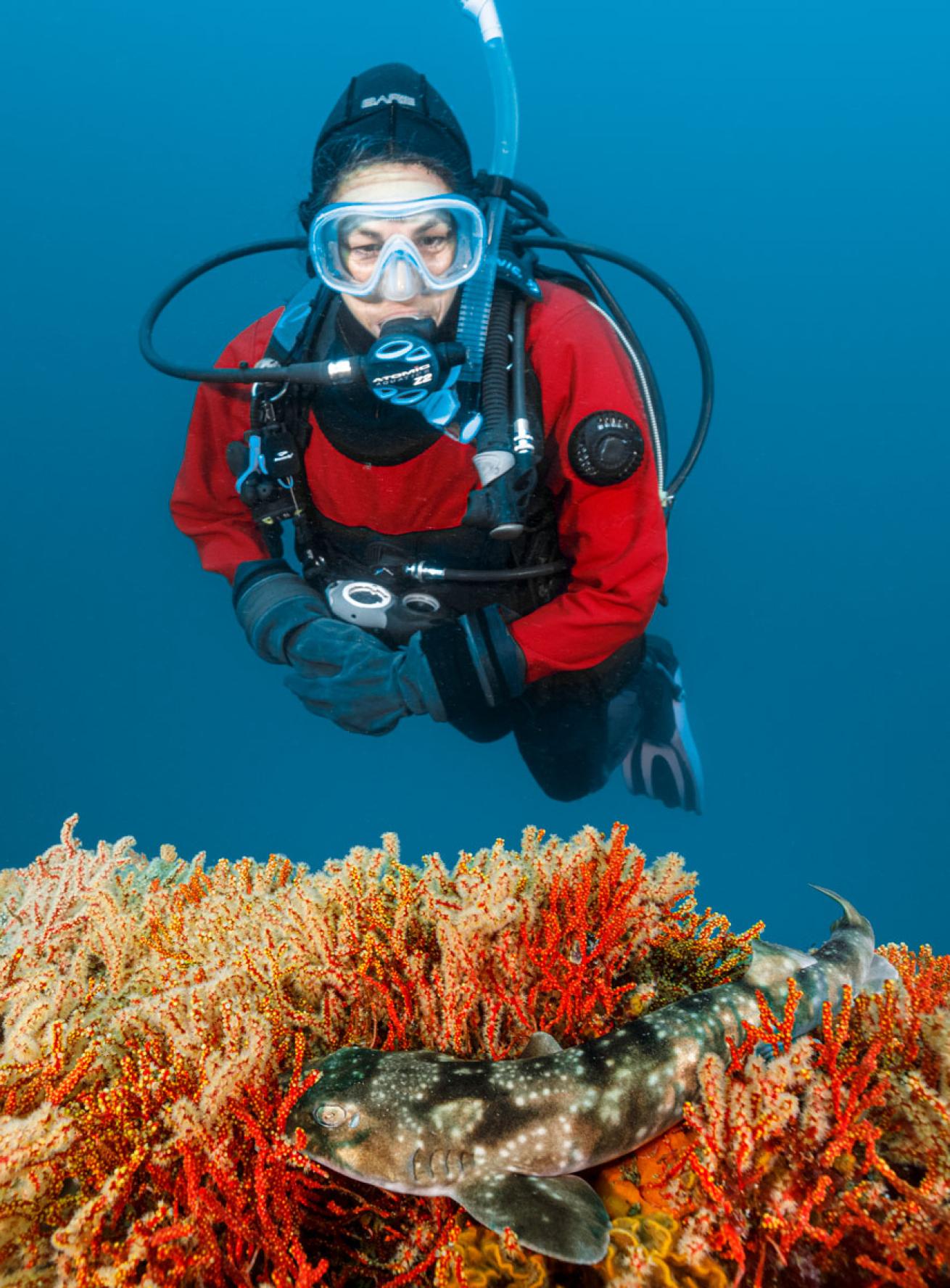
BRANDON COLEA diver diving in South Africa
Dive Conditions
Be prepared for anything! Cool water and potentially limited visibility, rough surface conditions, and strong surge can all contribute to make South Africa’s diving challenging at times. Ocean temperatures range between the low 50s at depth and about 70 degrees on the surface, depending on location, time of year and upwelling. Full wetsuits (5 to 7 mm) and drysuits are recommended. Underwater visibility ranges widely from as little as 5 feet to more than 50 feet. Large swells can generate very strong underwater surge. Even though poor conditions sometimes cancel boat charters and make shore entries unsafe, it is often possible to find a different site better protected from the wind and swell by a rocky headland or one of the capes. Local dive charter operators are experienced in choosing the best available dive sites based on current conditions.
Operators
Pro Dive Port Elizabeth (prodivepe.co.za) is a PADI Five Star Dive Center delivering the full gamut with regard to scuba training, gear rental, sales and service. Indigo Scuba Diving Centre (indigoscuba.com) is a very experienced, full-service, family-run operation in Gordon’s Bay offering boat charters, scuba courses and even bespoke photo instruction. They dive both sides of False Bay: Gordon’s Bay between October and May, and Simon’s Town between June and September. Shark Explorers (sharkexplorers.com) in Simon’s Town offers instruction (both scuba and freediving), sales, rentals, boat and shore dives, and specialty trips.
Travel Tips
Embrace beautiful South Africa above the waves to diversify your diving holiday. When sea conditions prevent diving, take a hike or two. There are countless options, most of which can be researched online so you can choose your trails based on length, skill level, etc. Bring proper hiking boots, layered clothing, rain jacket, and pants with zip-off lower legs. Temperature and weather can change dramatically with elevation. When hiking Table Mountain, many people choose to hike up and then take the cable car down. However, the gondola sometimes shuts down due to high winds, so check the forecasts and reports. Choose your trail routing up and down carefully just in case you have to round-trip it.
Plan a day or two in the big city. Cape Town is one of the world’s most vibrant metropolises, and its dining, entertainment and cultural offerings are spectacular.
South Africa has numerous game parks situated throughout the country that are home to elephants, lions and so many other creatures of the bush. Be sure to save time for a safari or two, whether it’s an afternoon self-guided tour or a multiday tented-camp game drive in Kruger National Park. Binoculars and a telephoto camera lens are very helpful for safari wildlife viewing and imaging. Speaking of wildlife, be very careful around any baboons, especially those on the Cape Peninsula near popular roadside stops. Do not carry any food, do not feed them, and do not leave any food whatsoever in your car.
We love having a rental car so we can move around at our own pace, adapt to the weather, change our plans and so on. For drivers from North America, be warned you drive on the left side of the road in South Africa. Also, rental cars almost always have the steering wheel placed on the righthand side, and many are manual (stick shift) transmissions to boot. This trifecta of driving differences can be potentially challenging for some people.
On the food front, try the banana bread French toast at the Peak Cafe in Fish Hoek. Refuel on the long road with delicious meat pies (and vegan too!) at Ou Meul bakeries. And if you get the chance to accept the invitation of a friendly local to come over for a braai—a South African-style barbecue that’s practically a cultural and culinary institution— don’t miss it!
Are you ready to step up, help save the ocean, and #LiveUnfiltered at the same time? [Sign up for a PADI Open Water Diver course now.]

